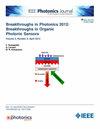Photonics Breakthroughs 2024: Advances in Heavy-Metal-Free Quantum Dot Shortwave Infrared Photodetectors and Image Sensors: The Case of Ag2Te QDs
IF 2.4
4区 工程技术
Q3 ENGINEERING, ELECTRICAL & ELECTRONIC
引用次数: 0
Abstract
Shortwave infrared (SWIR) light holds promising applications spanning consumer electronics, industrial automation, and biomedical imaging. The detection of shortwave infrared light lays in the centre of SWIR applications. Conventional SWIR detectors rely on epitaxial semiconductors, which are costly and limited by low manufacturing throughput. Colloidal quantum dots (CQDs) have been developed to unravel these issues and comparable device performances have been achieved after decades’ efforts. While CQDs can offer low-cost alternatives once high-volume maturity level is reached, their widespread adoption in consumer electronics market has been hindered also by concerns on the use of lead/mercury-based materials. Recent advances in heavy-metal-free CQDs, such as silver chalcogenides (Ag2Te) and III-V semiconductors (InAs, InSb), have demonstrated performance metrics, which, in some cases, rival heavy-metal based counterparts. Progress in synthesis, surface passivation, and device engineering have enabled high detectivity (>10¹² Jones), broad spectral tunability (1000–2000 nm), monolithic integration with silicon readout circuits and proof of concept demonstration in image sensor and LIDAR use cases. These breakthroughs position heavy-metal-free CQDs as an environmentally compliant, scalable solution for next-generation SWIR technologies.光子学突破2024:无重金属量子点短波红外探测器和图像传感器的进展:以Ag2Te量子点为例
短波红外(SWIR)光在消费电子、工业自动化和生物医学成像等领域有着广阔的应用前景。短波红外光的探测是SWIR应用的核心。传统的SWIR探测器依赖于外延半导体,这是昂贵的,受限于低制造吞吐量。胶体量子点(CQDs)的发展已经解决了这些问题,并且经过几十年的努力已经实现了类似的器件性能。虽然一旦达到大批量成熟水平,CQDs可以提供低成本替代品,但对铅/汞基材料使用的担忧也阻碍了它们在消费电子市场的广泛采用。最近在无重金属CQDs方面的进展,如银硫族化物(Ag2Te)和III-V半导体(InAs, InSb),已经证明了性能指标,在某些情况下,可以与基于重金属的CQDs相媲美。合成、表面钝化和器件工程方面的进展使高探测性(bbb10¹²Jones)、广谱可调性(1000-2000 nm)、与硅读出电路的单片集成以及图像传感器和激光雷达用例中的概念验证演示成为可能。这些突破使无重金属cqd成为符合环境要求、可扩展的下一代SWIR技术解决方案。
本文章由计算机程序翻译,如有差异,请以英文原文为准。
求助全文
约1分钟内获得全文
求助全文
来源期刊

IEEE Photonics Journal
ENGINEERING, ELECTRICAL & ELECTRONIC-OPTICS
CiteScore
4.50
自引率
8.30%
发文量
489
审稿时长
1.4 months
期刊介绍:
Breakthroughs in the generation of light and in its control and utilization have given rise to the field of Photonics, a rapidly expanding area of science and technology with major technological and economic impact. Photonics integrates quantum electronics and optics to accelerate progress in the generation of novel photon sources and in their utilization in emerging applications at the micro and nano scales spanning from the far-infrared/THz to the x-ray region of the electromagnetic spectrum. IEEE Photonics Journal is an online-only journal dedicated to the rapid disclosure of top-quality peer-reviewed research at the forefront of all areas of photonics. Contributions addressing issues ranging from fundamental understanding to emerging technologies and applications are within the scope of the Journal. The Journal includes topics in: Photon sources from far infrared to X-rays, Photonics materials and engineered photonic structures, Integrated optics and optoelectronic, Ultrafast, attosecond, high field and short wavelength photonics, Biophotonics, including DNA photonics, Nanophotonics, Magnetophotonics, Fundamentals of light propagation and interaction; nonlinear effects, Optical data storage, Fiber optics and optical communications devices, systems, and technologies, Micro Opto Electro Mechanical Systems (MOEMS), Microwave photonics, Optical Sensors.
 求助内容:
求助内容: 应助结果提醒方式:
应助结果提醒方式:


